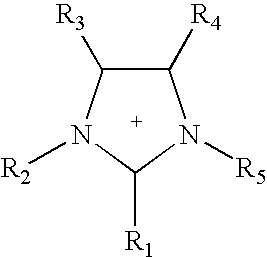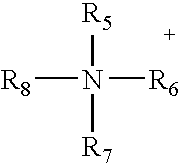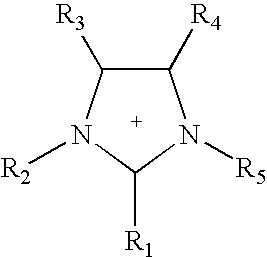Non-aqueous electrolytes for electrical storage devices
a non-aqueous electrolyte and electrical storage technology, applied in the direction of non-aqueous electrolyte cells, electrochemical generators, electrolytic capacitors, etc., can solve the problems of low power capability, high viscosity typically associated with high dielectric constant solvents used in non-aqueous electrolyte, and detrimental to conductivity in porous electrodes. , to achieve the effect of optimum capacitance, high energy density, and high conductivity
- Summary
- Abstract
- Description
- Claims
- Application Information
AI Technical Summary
Benefits of technology
Problems solved by technology
Method used
Image
Examples
example 1
[0039]As an example of a process for preparing the tetraalkylammonium F(HF)x salts, the following procedure was used to prepare tetraethylammonium F(HF)2.33.
[0040]At least 60 g (minimum of a four-fold excess of anhydrous HF) is added to 100 g of tetrethylammonium chloride under dry atmosphere in a PFA bottle or reactor. The mixture is heated and stirred up to 110° C. A vacuum is then applied to the liquid for two hours while stirring at this temperature. The fluid is allowed to cool under inert atmosphere and it crystallizes at about 60° C. The clear large colorless crystals are broken up and cooled. The material is free of chloride (silver nitrate test) and crystalline. The yield is quantitative. The crystals are stored in a moist-free container either of aluminum or PFA or polyethylene under nitrogen or argon.
[0041]The new crystalline salt tetraethylammonium F(HF)2.33 as determined by titration readily dissolves in acetonitrile or other nitrites and dinitriles forms stable solutio...
example 2
[0042]Preparation of[(Tetraethylammonium) (FHF)]3[HF]4 complex salt (HF / F=2.33 mole basis).
[0043]Added 330 g(2 ml) tetraethylammonium chloride slowly to 240 g(12 m) anhydrous HF protected from the atmosphere under argon with stirring with cooling in a Teflon bottle (PFA). The solution was maintained between 20-40° C. with an argon stream to remove the excess HF and the hydrogen chloride. (No chloride remained in the liquid as determined by testing with aqueous silver nitrate). Transferred in the liquid to a vacuum chamber and maintained it at 100° C. for 3 hours. Broke the vacuum with argon and cooled. The liquid solidified at about 50-60° C. Determined the HF content by titrating the acid level with sodium hydroxide solution. It was found to correspond exactly to theoretical. HF / F=2.33. Conductivity of the salt was 90.8 mS / cm at 25° C. and 1.5 M in acetonitrile.
example 3
Preparation of Tetraethlamonium F(HF)x, (HF / F=1.50
[0044]The salt of example (1) was heated under vacuum to 150° C. and vacuum for four hours and then cooled and bottled under inert atmosphere. The titration showed that the HF / F ratio was now 1.50. The melting point of the solid was now about 100-110° C. The conductivity of this salt was 67.0 mS / cm at 1.0 M in acetonitrile at 25° C.
PUM
 Login to View More
Login to View More Abstract
Description
Claims
Application Information
 Login to View More
Login to View More - R&D
- Intellectual Property
- Life Sciences
- Materials
- Tech Scout
- Unparalleled Data Quality
- Higher Quality Content
- 60% Fewer Hallucinations
Browse by: Latest US Patents, China's latest patents, Technical Efficacy Thesaurus, Application Domain, Technology Topic, Popular Technical Reports.
© 2025 PatSnap. All rights reserved.Legal|Privacy policy|Modern Slavery Act Transparency Statement|Sitemap|About US| Contact US: help@patsnap.com



